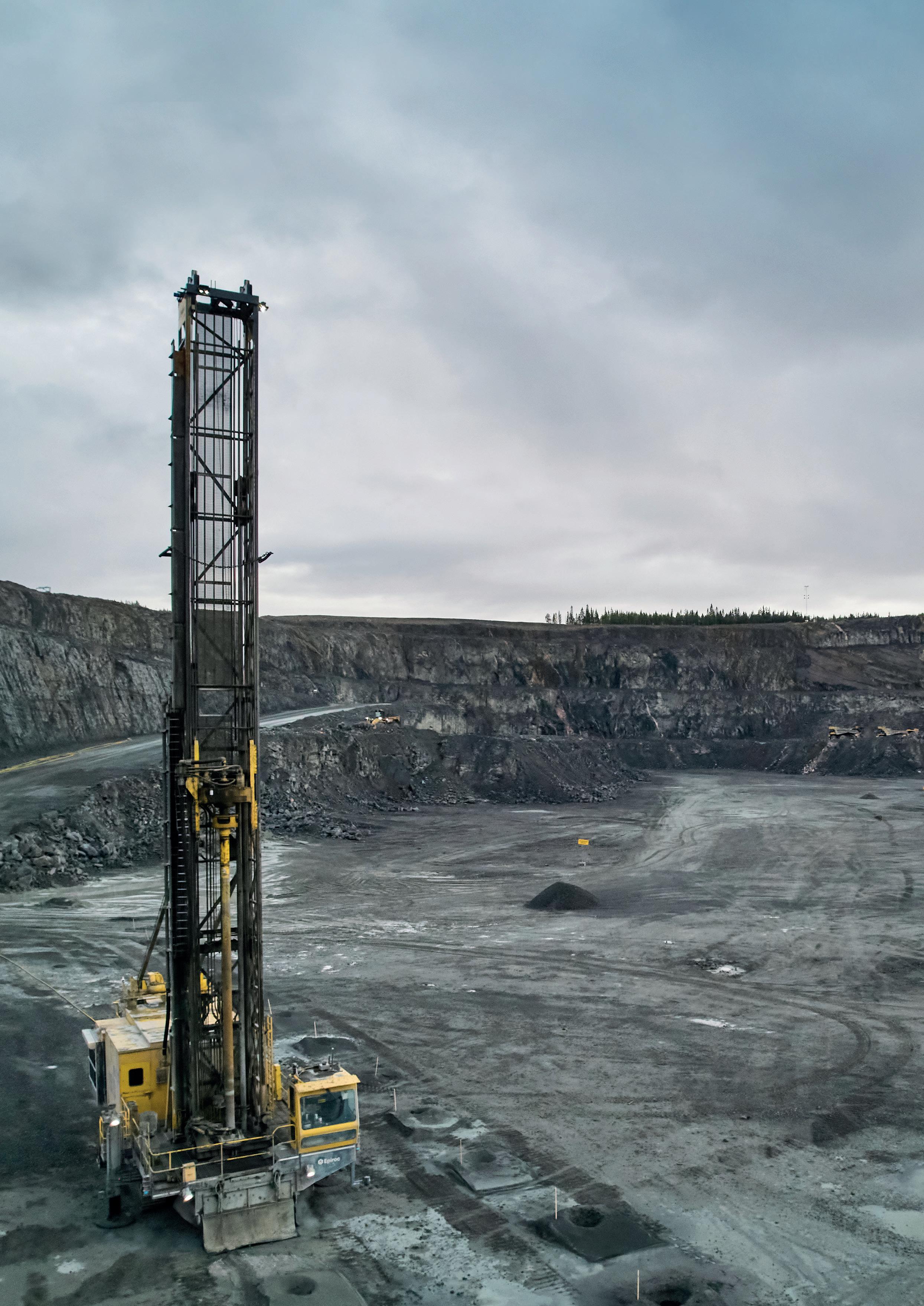
8 minute read
A Rugged Solution
Daniele Bonaiti, CICSA, Italy, analyses the benefits of adopting round steel link chain equipment for wheel bucket elevators.
As a classic movie once said, “when the going gets tough, the tough get going.” This is perhaps also the case for round steel link chain equipment for bucket elevators and conveyors, a rugged solution for tough and heavy load material handling applications.
Compared with all the alternatives, round steel chains offer: (a) low cost; (b) a long, trouble-free lifetime; (c) easy monitoring and minor maintenance requirements; (d) self-cleaning operation; and (e) adaptability to practically any granularity, chemical, and temperature specification of the transported product.
Through the decades, this type of chain equipment has become a preferred technology for heavy load and heavy-duty machines in mines and quarries, cement factories, as well as in industrial uses; such as power generation and ash handling. In recent years, a few major manufacturers – including CICSA

Figure 1. Schematic layout of a smooth wheel bucket elevator.
Figure 2. An example of a CICSA smooth drive wheel with replaceable forged segments (RLS type).
Figure 3. A toothed wheel for CICSA round link chain in preparation before delivery. – have further developed round steel link chains and accessories with additional technological refinement.
Focusing on their application to bucket elevators (Figure 1), two technologies are in place: n Smooth wheel bucket elevators, using either: short strand chains (e.g. classic DIN764 type, generally with three, five, or seven links) and bucket attachment with shackles; or long strand chains with clamp-type attachments – in both cases, using smooth driving wheels. n Toothed wheel bucket elevators, using long strand chains (e.g. CICSA LH type), to which buckets are attached with couples of pins or with specific clamps (ATS type) and toothed driving wheels.


Smooth wheel bucket elevators
Smooth wheel bucket elevator technology, which has the longest history in installations (dating back to the early 1950s), has demonstrated the highest flexibility in an extremely wide range of application and is still a preferred choice in many sectors. As an example, CICSA supplies components for elevators transporting from a few tph of abrasive dust at room temperature to a hundred tph of chemical reactants at high temperature (400 – 500˚C), or up to 1000 tph raw materials with variable particle size. The latter capacity is reached in elevators running with Ø36 – Ø42 mm CICSA 3HS equipment (the diameter refers to the size of the round steel composing the chain).
The three main elements allowing the bucket charge, elevation, and discharge – and thus the transport of bulk materials – in the machine are: n The driving and return wheels. n The chain strands. n The shackles which connect the chain to the buckets.
Driving and return wheels
Driving and return wheels are generally constructed with a central hub (e.g. fixed on a keyed shaft) and replaceable peripheral chain guides (or segments) bolted onto the hub. The chain links lie, one by one, alternatively in a flat position on the segments or vertically in a continuous central cavity, which allows the discharge of excess material depositing on the wheels during operation.
The transmission of torque between the driving wheels and the chain happens thanks to friction between the smooth guide segments and the chain links. This mechanism is not significantly influenced by the chain size. This is a distinctive advantage towards all toothed wheel equipment, regardless of the chain type, where, conversely, a correct gearing can be ensured only up to relatively small variations of the chain pitch. On the other hand, friction occurs thanks to the tensioning effect created by the weight of the chain equipment combined with the pre-tensioning of the return wheel; the latter can be increased but tends to become impractical (although exceptions do exist) when the height of the machine goes above 40 – 45 m (measured as wheels centre distance between the driving and return stations).
Unlike the traditional execution of the guides, which was based on cast components, the modern approach proposed by CICSA is based on high-volume manufacturing of light and extremely robust forged segments (covering 30˚ – 45˚ of the
wheel circle) made of special chromium-molybdenum (CrMo) alloys, assembled on simple design wheel hubs (Figure 2).
Chain strands
Chain quality has steadily evolved over the years. CICSA is proposing high-class solutions (3HS and 3HX type) featuring high surface hardness (800 – 820 HV) and high carburising depth; up to 15 – 20% of diameter in terms of total hardening depth and 10 – 15% effective case depth (reference CHD 550 HV1, ISO2639). The case depth is often underestimated, since the smooth wheel drive can work effectively even in presence of large chain pitch variations – a chain with a thicker hardened layer (e.g. high hardening depth) can ensure a much longer lifetime with uniform distribution of wear and tear.
Together with their high hardness profiles, 3HS and 3HX chains offer a high tensile strength, equal or exceeding those of conventional products and ideally fitting the requirements of the heaviest applications.
Shackles
Shackles are classically designed to combine two critical roles: connecting the adjoining chain strands and sustaining the buckets. They must bear both the chain load and the forces related to excavation and rotation of the buckets, and they are subjected to fatigue stress in the machine operating cycles.
Novel solutions in the field include the special patented treatment C-HARD® proposed by CICSA, which combines superior hardness at interlink (800 HV) with high core toughness and the use of high-precision closing plates. This solution ensures trouble-free operation, even in the most demanding machines, in terms of capacity, height, and material abrasiveness.
As an alternative, shackles can be substituted with clamp-type attachments (ATS type, see also the next section), mounted on long chain strands.
Toothed wheel bucket elevators
The highest speed and capacity elevators are generally built with toothed driving wheels. This solution allows the transmission of torque and movement without relying on pure friction, making possible to carry any kind of bulk material without adding any significant pre-tensioning load on the chain system. Moreover, it allows for the machine in question to be run at higher speed (e.g. up to around 1.5 m/sec. vs the typical 1.3 m/sec. of smooth wheel elevators).
Remarkable applications have been successfully proposed in the last years, especially for raw material and clinker transportation, where large round link chain elevators have performed very well using CICSA LH Ø30 mm to Ø38 mm chains.
The three main elements facilitating the bucket charge, elevation, and discharge – and thus the transport of bulk materials – in the machine are: n Driving and return wheels. n Chain strands with intermediate couplings.
FLOTATION 360™
Complete your circuit with the chemical, service and predictive capabilities of FLOTATION 360:
Advanced Chemistry Superior, customized frothers and collectors
Global network of technical consultants and labs ensuring continuous service and support
Optimize performance to increase recovery Reduce potential impacts of future ore changes Enhance reagent dosing and consumption Peace of mind for an efficient, productive, and optimized flotation operation

Expert Service

Digital Solution
COMPLETE, END-TO-END FLOTATION OPTIMIZATION



n Attachments which connect the chain to the buckets.
Driving and return wheels
Wheels are built with a central part constituted by a hub and a peripheral double flange (in grey in Figure 3). Teeth, which are easily replaceable, are made of special alloy steels, case hardened up to the same hardness and depth specifications of the chain and are bolted onto the wheel flange for easy mounting and disassembling. Return wheels instead feature a smooth and continuous guide, with a construction very similar to the Figure 4. Hardness profiles of most advanced chain qualities for toothed wheel bucket one discussed in the elevators (CICSA LH type). previous section. Aiming to extend the chain equipment lifetime, teeth can be changed when the chain pitch grows beyond 2.5 – 3% of its original size due to wear and tear, using oversized teeth which allows for the correct gearing to be restored on worn chains. This technique can extend chain useful lifetime by up to 30 – 40%. Furthermore, CICSA teeth are symmetrical and reversible, so that the very same teeth can be turned and re-used at the appropriate time with the following chain equipment. Figure 5. Driving station of a toothed wheel bucket elevator with Ø34 mm CICSA LH-CS chain and GV34 couplings. Figure 6. Bucket attachment with ATS type components. Chain strands and couplings
CICSA is proposing high-class solutions (from LH-B to
LH-CS type) featuring high surface hardness (820 – 830 HV) and high carburising depth, up to 12 – 15% of diameter in terms of total hardening depth and 9 – 12% effective case depth (reference CHD 550 HV1, ISO2639; see some examples in Figure 4). The case depth is especially important when a possible use of the above-mentioned
‘oversized teeth’ technology is envisaged. The chain is mounted in long chain strands, with few and simple couplings connected at each end; see for example the two couplings with flat plates (which are visible in Figure 5), between the green ends of the chain.
Bucket attachments
The pitch between the buckets can be chosen according to different needs. Buckets are installed after the setting up of the chains. The bucket attachment can be constituted by pins, which are directly inserted in the chain links and in plates welded to the buckets (Figure 5). Alternatively, buckets can be attached with clamps type ATS (Figure 6), which offer a very simple, robust, and inexpensive option.
Conclusion
The adoption of a suitable choice of round steel link chain equipment ensures robustness and reliability in heavy-load bulk material handling applications, including those featuring: harsh operating conditions, transport of corrosive materials, operation at high temperature, and/or handling of extremely abrasive materials.











